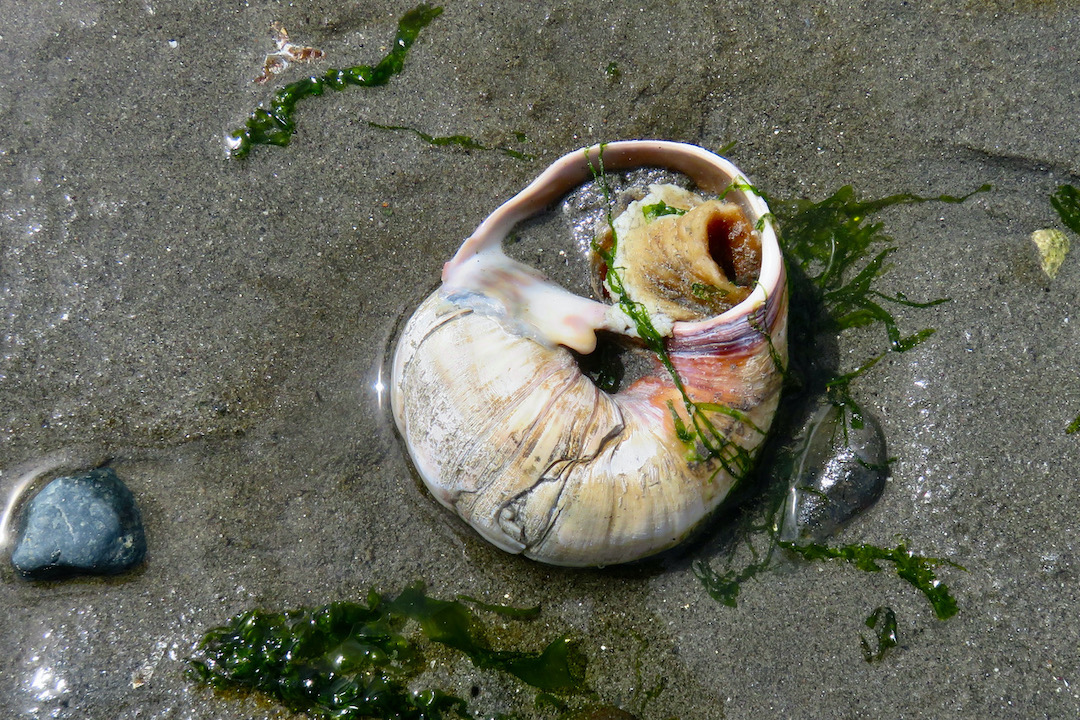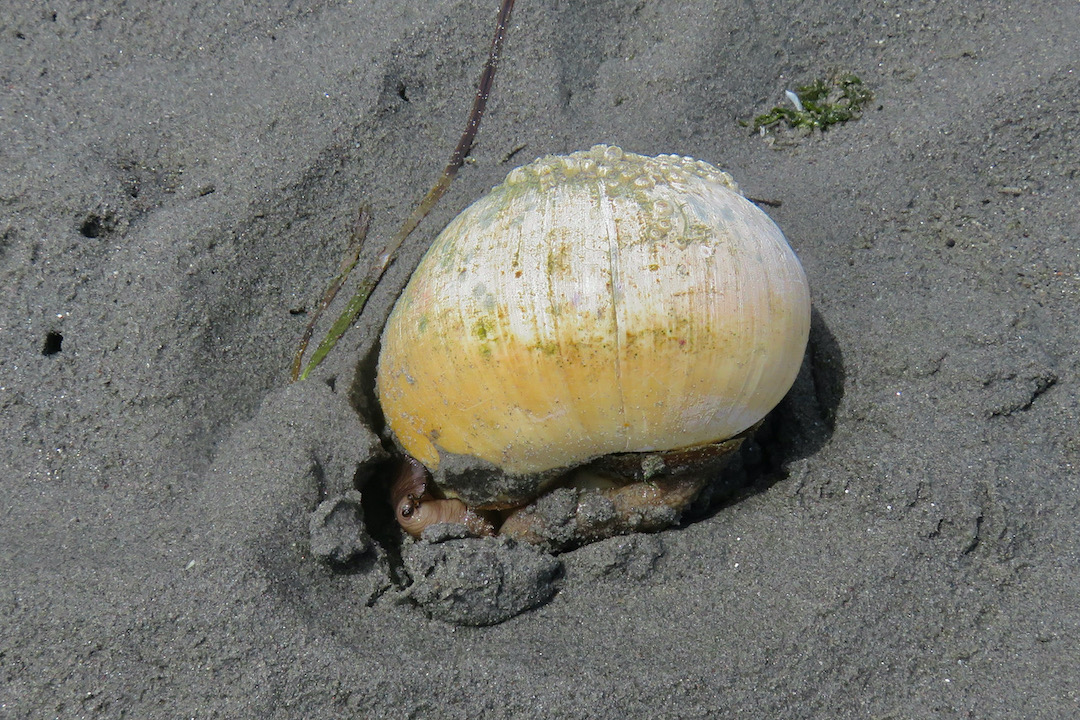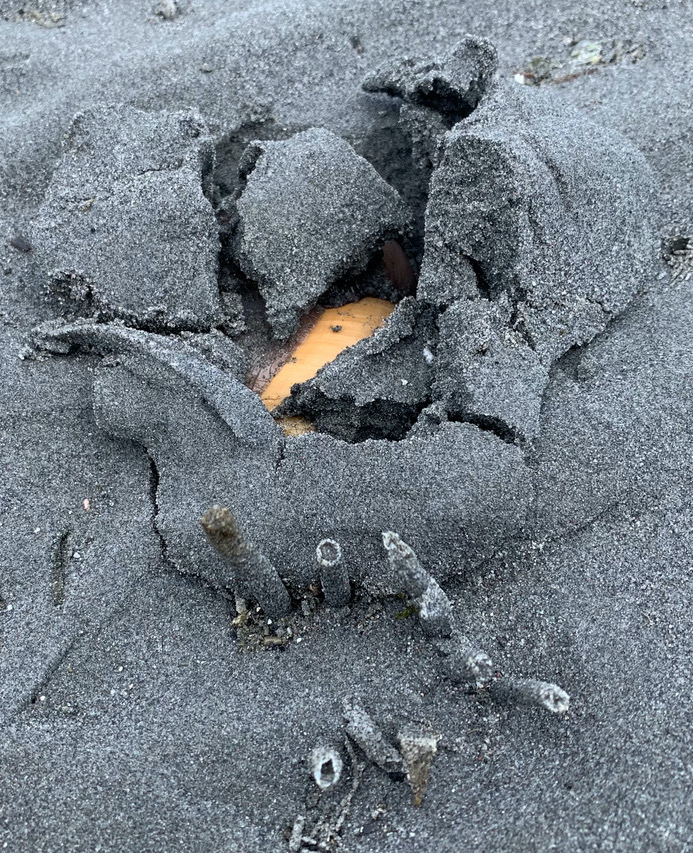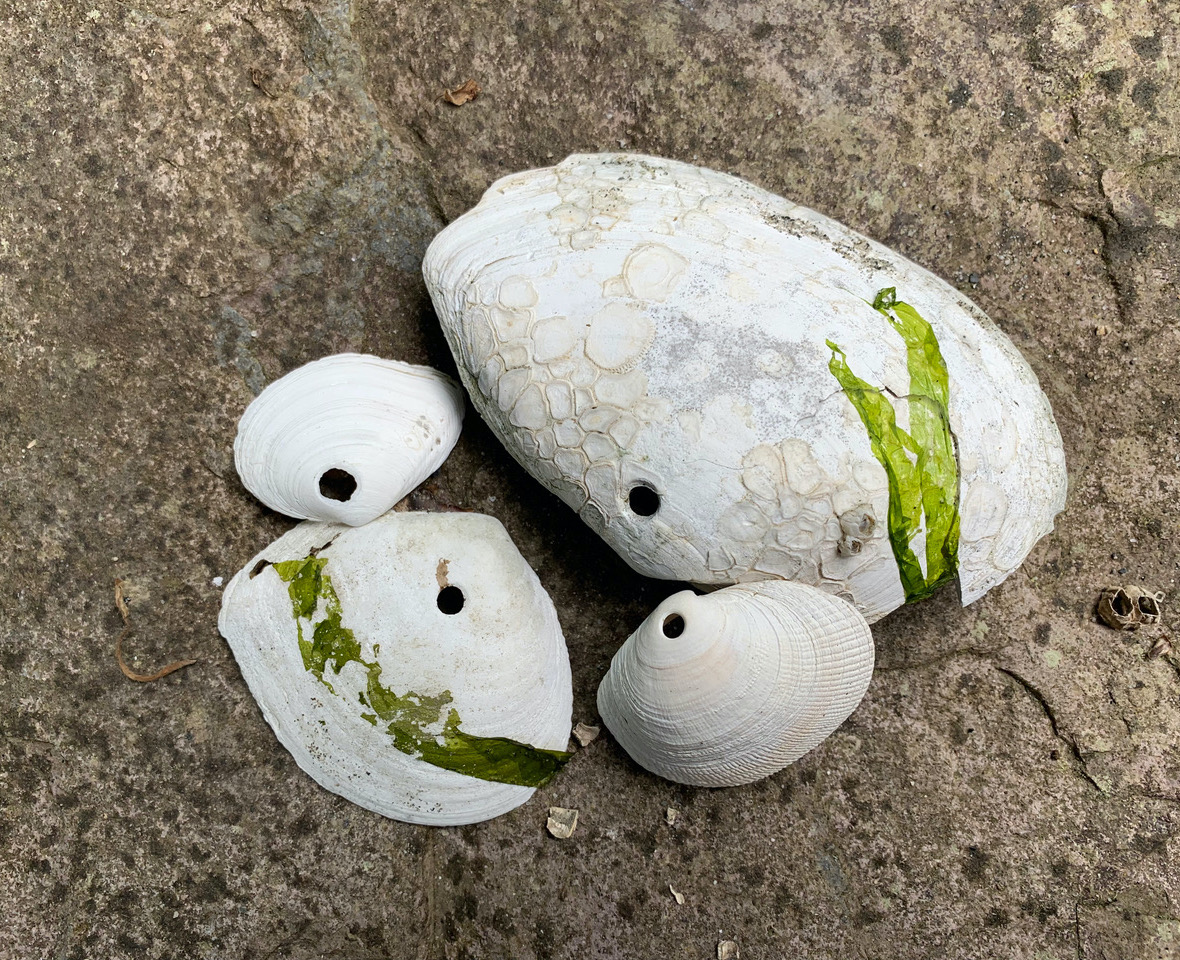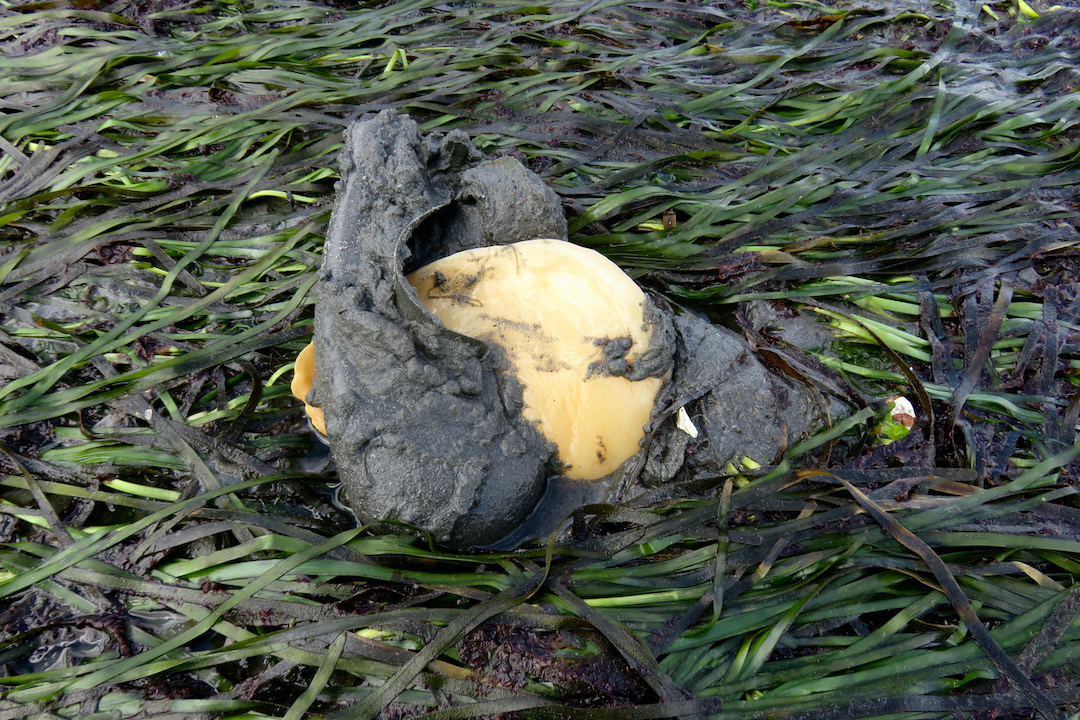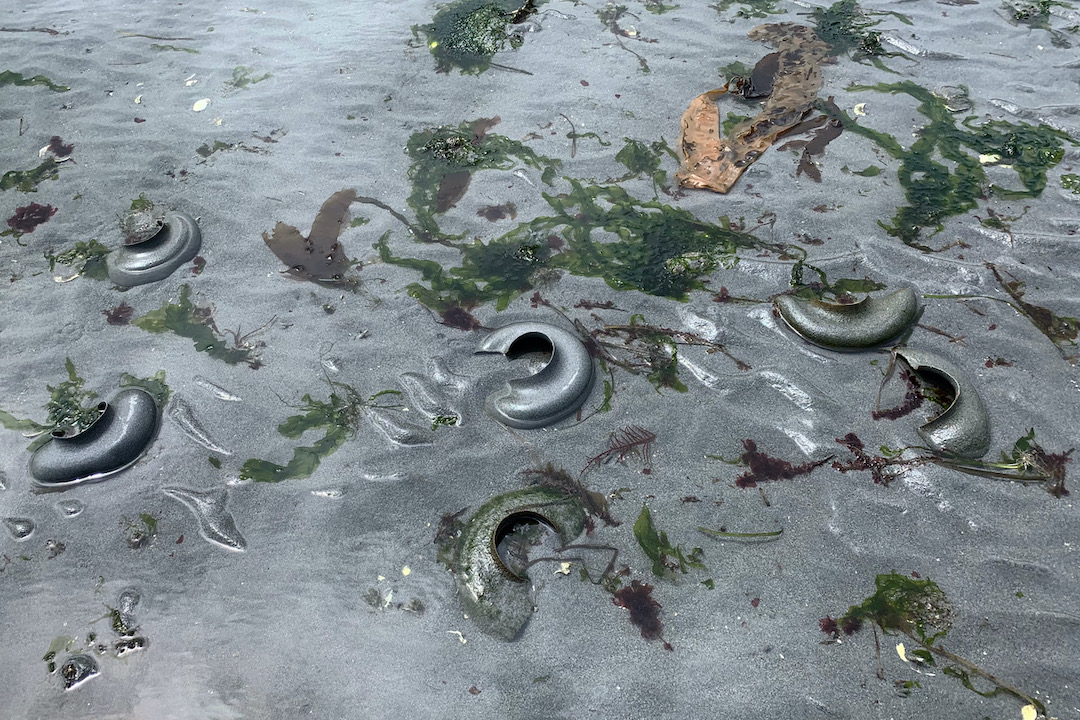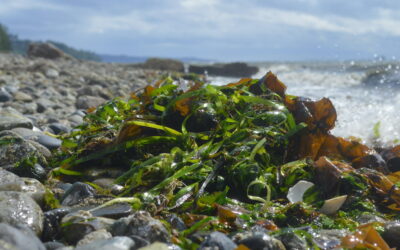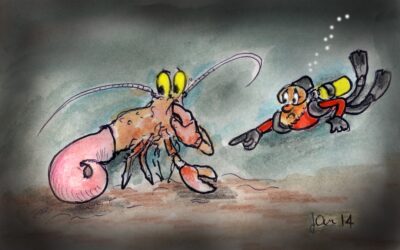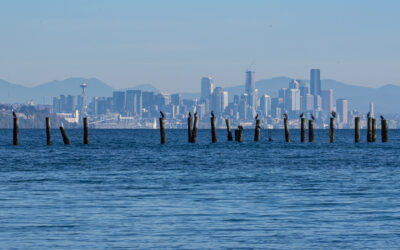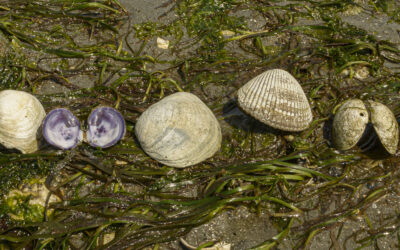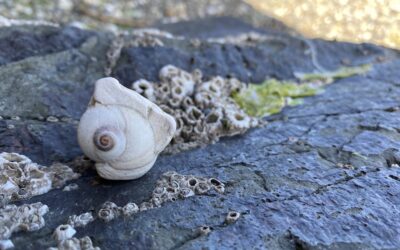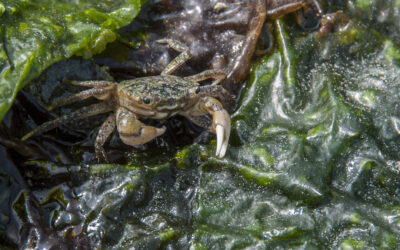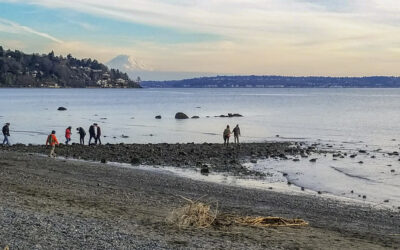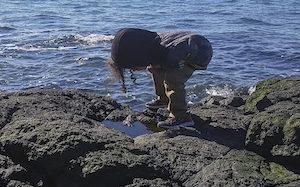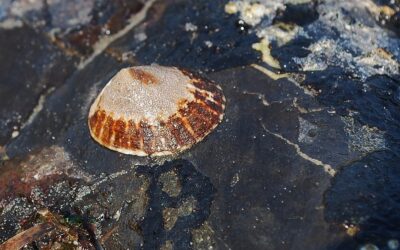MOON SNAILS AT LOW TIDE
by Marilyn DeRoy, Summer 2021
Photos & video by Marilyn DeRoy
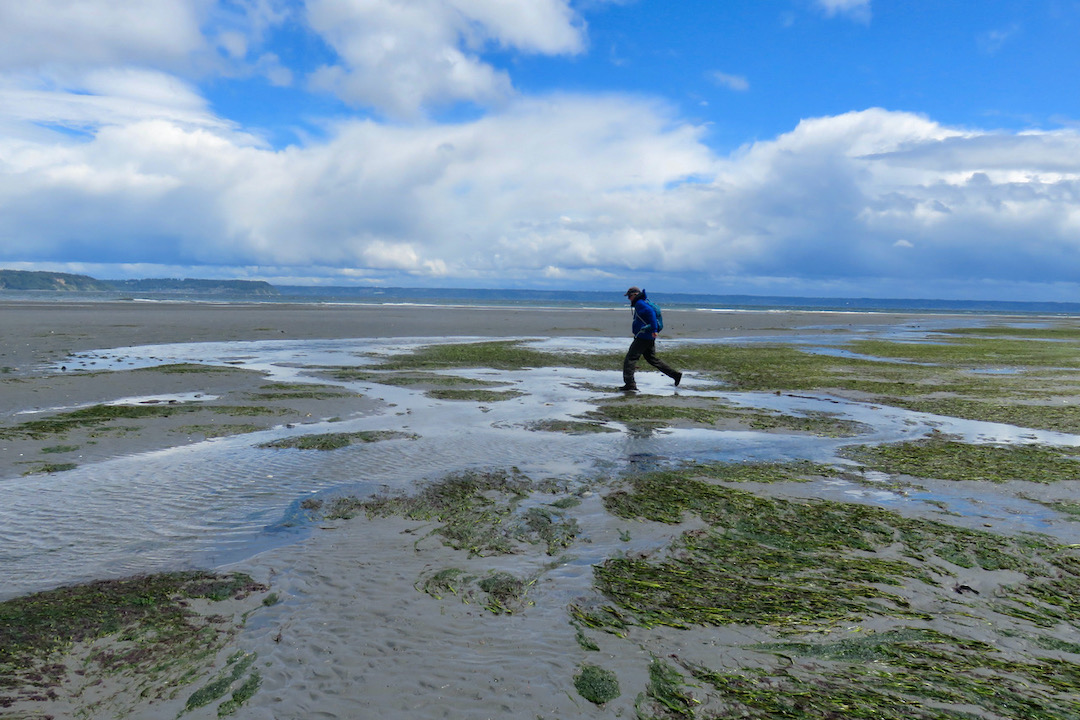
MOON SNAILS AT LOW TIDE
By Marilyn DeRoy, Summer 2021
Photos & video by Marilyn DeRoy
At the end of May, we had two days of minus 3.8’ (minus 1.15 m) tides at the northern end of the Kitsap Peninsula; wonderful for exploring the intertidal zone.
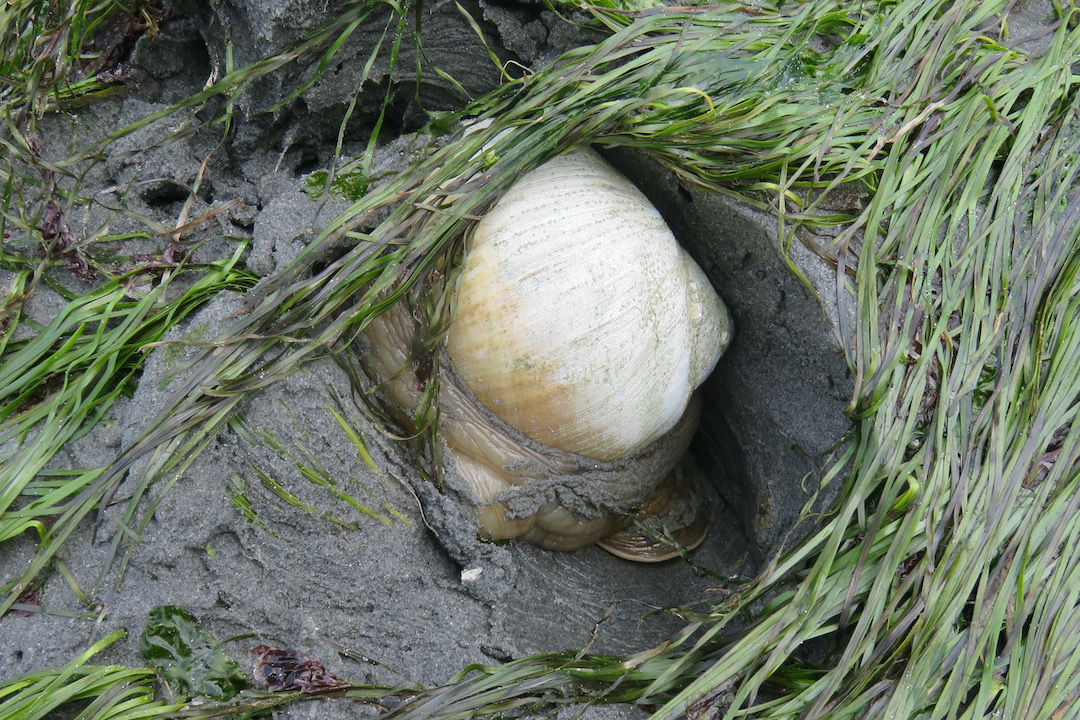
This moon snail is using its foot to burrow into the sand, where it may find food. It can then expand its foot to smother clams and other bivalves that become its prey.
Hidden under the wet sand in the company of tube worms, this moon snail is barely visible. The disturbance at the surface of the sand is a good indicator that you may find a moon snail just below. This moon snail may have found a meal!
The circular hole in the clam shell likely means that it became a meal for a moon snail. The moon snail uses its radula, with its seven rows of teeth, to make a hole in the clam shell. It can secrete enzymes to help soften the shell, then it uses its proboscis to suck out the innards. This can take many hours, even a couple of days. In the laboratory it’s been observed that one clam will satisfy a moon snail for four days.
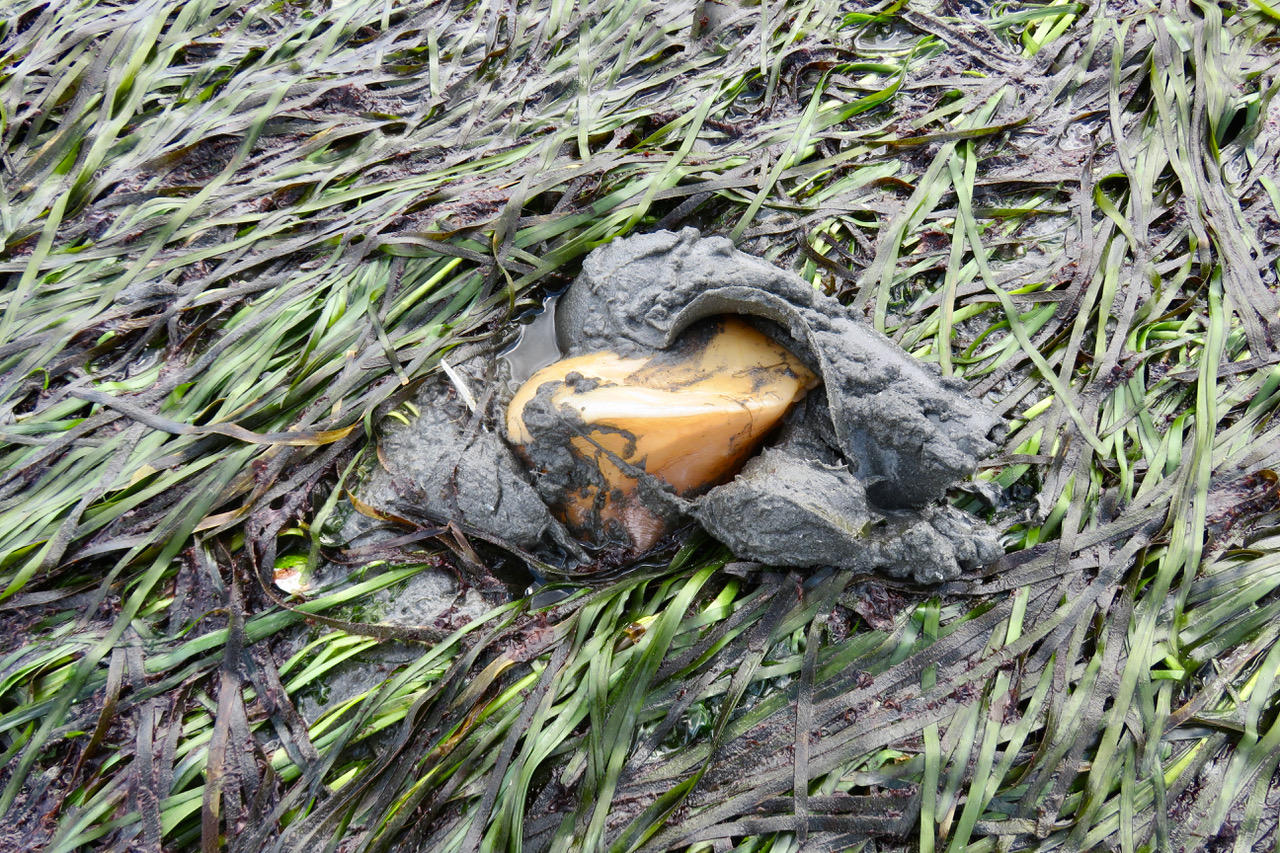
In spring and summer, the moon snail comes in from the deep water to the intertidal zone, where it lays hundreds of thousands of eggs. It uses its foot to surround the eggs with a mixture of sand and mucus that hardens into a protective egg case, or sand collar.
This moon snail appears to have finished its egg case and to have begun to move out from under it. The eelgrass beds provide important habitat for many sea animals.
In this video we’re likely seeing the moon snail removing itself from the egg case that it built around its shell. This is a good illustration of the expression “at a snail’s pace.”
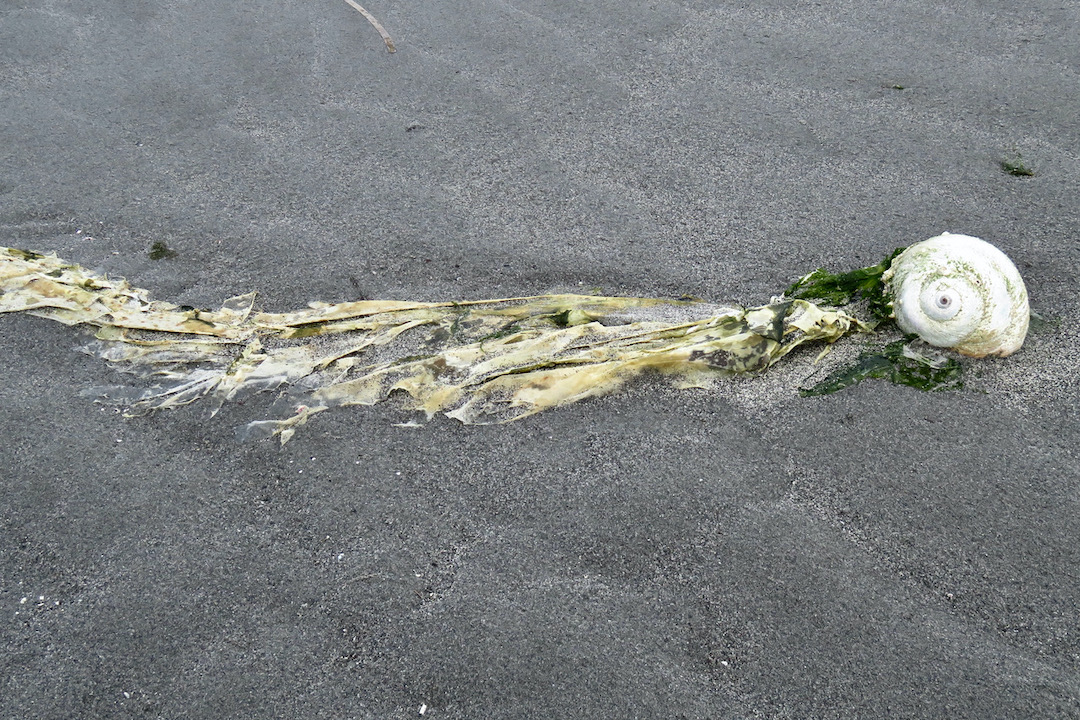
Sometimes seaweed attaches to the spherical moon snail shells, creating decorations on the beach.
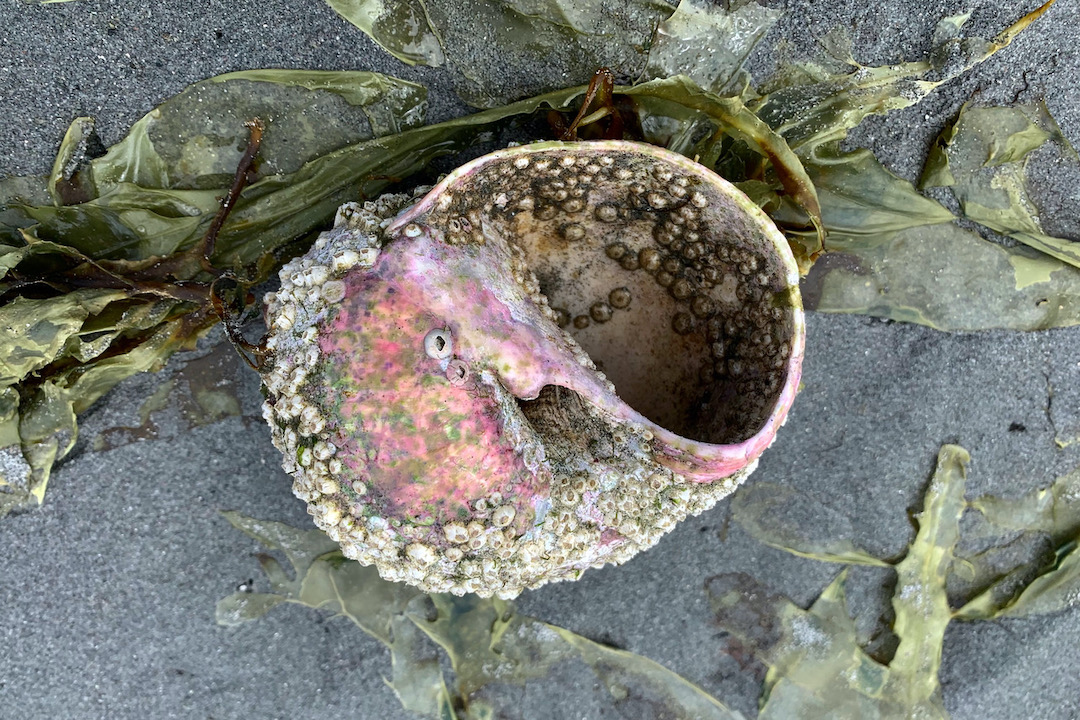
Sometimes barnacles attach to moon snail shells.
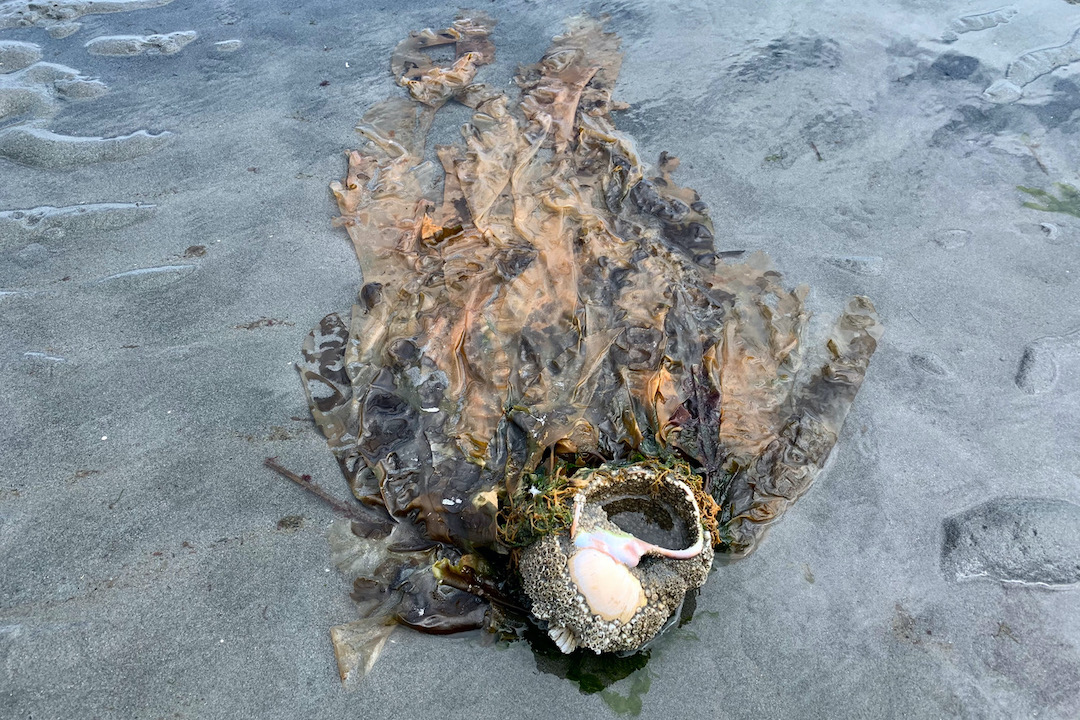
You might even find a moon snail shell filled with water, creating a reflecting pool for you to look into.
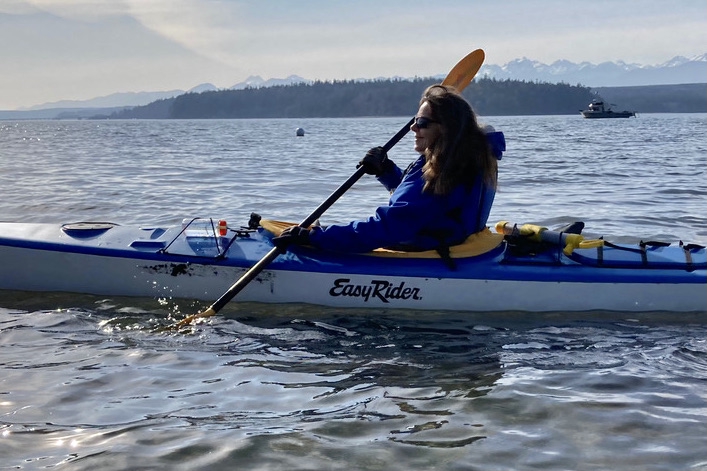
Marilyn DeRoy has enjoyed outdoor opportunities wherever she has been, including backpacking, canoeing, cross-country skiing in British Columbia; hiking, camping, raising horses in the high desert of eastern Oregon, where she also taught school and volunteered at the John Day Fossil Beds. She and her husband, Jim, now live in Hansville, and they volunteer with Hansville Greenway, Buck Lake Native Plant Garden, and Port Gamble Forest Heritage Park. Almost every day they are out somewhere hiking, biking, or kayaking, and finding photo opportunities as a way to share the natural environment that they so much appreciate.
Table of Contents, Issue #12, Summer 2021
Beach Wrack
by Nick Baca, Summer 2021 photos by Nick Baca except as notedby Nick Baca, Summer 2021 photos by Nick Baca except as notedOn a warm sunny day, the shores of Puget Sound are filled with the smell of rotting seaweed. Flies are heard before they are seen, swarming above...
Hermit Crabs
by Sadie Bailey, Summer 2021 photos and drawings by Jan Kocian fact checked by Greg Jensenby Sadie Bailey, Summer 2021 photos and drawings by Jan Kocian fact checked by Greg Jensen The waves fly onto the beach as if they were racing each other. Which one can...
Piling Up
by Jeff Adams, Summer 2021 photos by Jeff Adams except as noted fact checked by Andy Lambphoto by John F. Williamsphoto by John F. Williamsby Jeff Adams, Summer 2021 photos by Jeff Adams except as noted fact checked by Andy LambAs a marine ecologist and nature...
RVs of the Beach
by Tom Noland, Summer 2021 photos by Tom Noland except as noted fact-checked by Greg Jensenby Tom Noland, Summer 2021 photos by Tom Noland except as noted fact-checked by Greg JensenWalking the shore of Cama Beach State Park on one of the lowest tides in recent...
Shell Shapes
by Chris Rurik, Summer 2021photo by Sarah Cavanaughphoto by Sarah Cavanaughby Chris Rurik, Summer 2021 Photos by Sarah CavanaughI have a collection of broken shells. They litter my desk and drawers, wave-smoothed fragments of curves and spirals, half-bleached, like...
A Rainbow of Crabs
by Laura Marx, Summer 2021 fact-checked by Greg Jensen photo by John F. Williamsphoto by John F. Williamsby Laura Marx, Summer 2021 fact-checked by Greg Jensen On a Saturday in early March, in an attempt to shake off the last of the winter lockdown slump, my partner...
Poetry-12
Summer 2021Photo by Jessica C. LevinePhoto by Jessica C. LevineSummer 2021To begin this section of poetry, here are three haikus which speak to our excessive heat this summer.by Drea Dangerton Cold water absentDrive belt for water massesFrayed, hardly churning...
Hello Under There
Proper Etiquette for Exploring the Beach by Sarah Lorse, Summer 2021 photo by Kaylani Siplinphoto by Kaylani SiplinProper Etiquette for Exploring the Beach by Sarah Lorse, Summer 2021 At first glance, the beaches along the Salish Sea may seem desolate, except for the...
Home Sweet Home
by Barbara Erickson, Summer 2021 Photos by Barbara Erickson except as noted by Barbara Erickson, Summer 2021 Photos by Barbara Erickson except as notedWHOOPEE! With the approach of summer and loosening of COVID restrictions, it’s time to head out exploring! For me,...
PLEASE HELP SUPPORT
SALISH MAGAZINE
DONATE
Salish Magazine contains no advertising and is free. Your donation is one big way you can help us inspire people with stories about things that they can see outdoors in our Salish Sea region.
We also don't advertise Salish Magazine, so please spread the word of this online resource to your friends and colleagues.
Thanks so much for your interest and your support.
We also don't advertise Salish Magazine, so please spread the word of this online resource to your friends and colleagues.
Thanks so much for your interest and your support.

